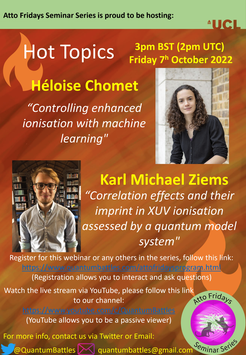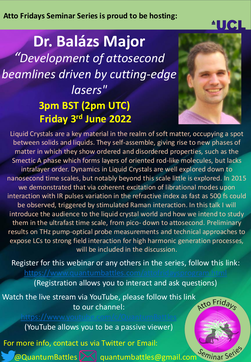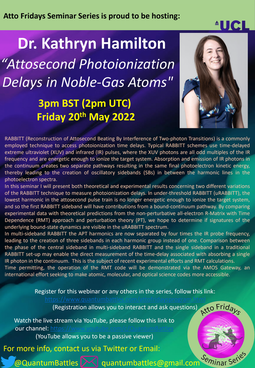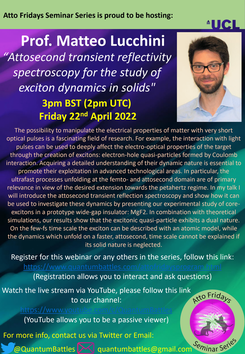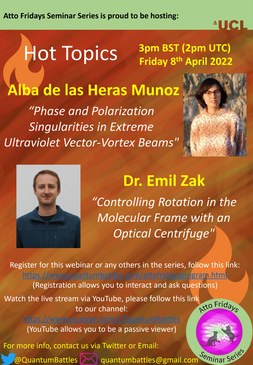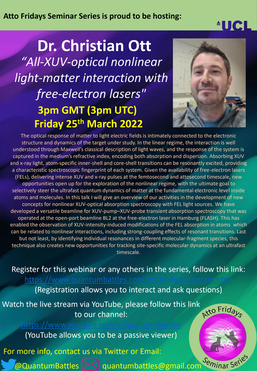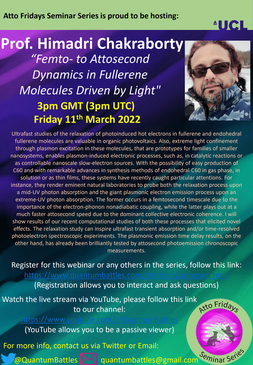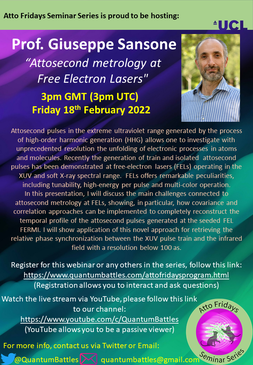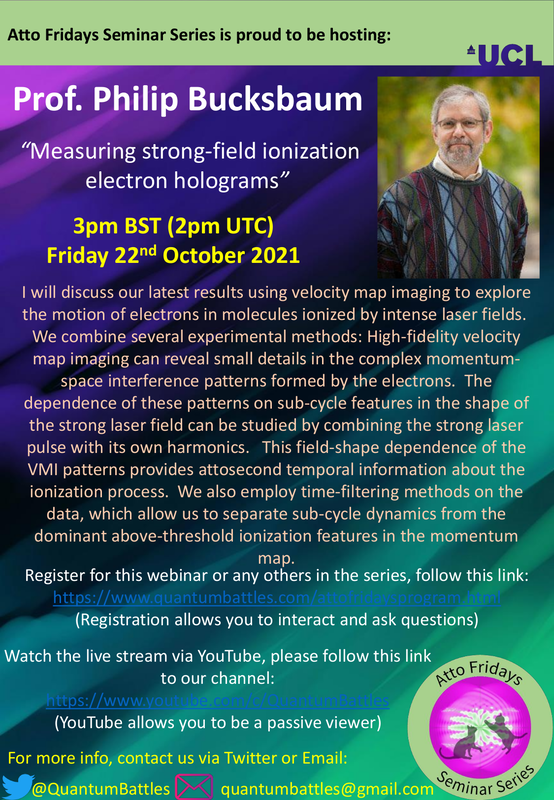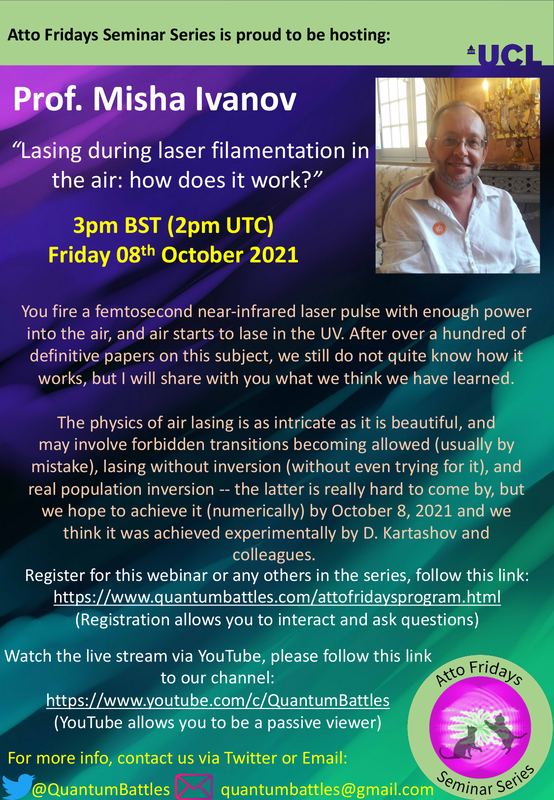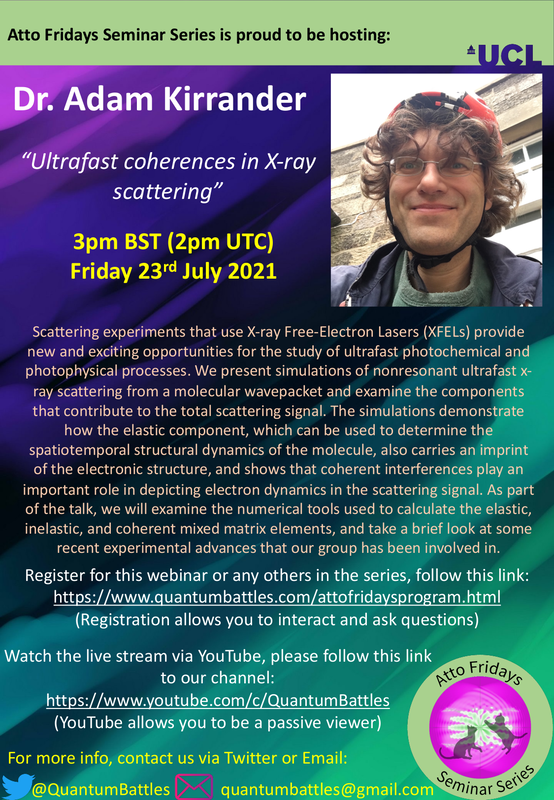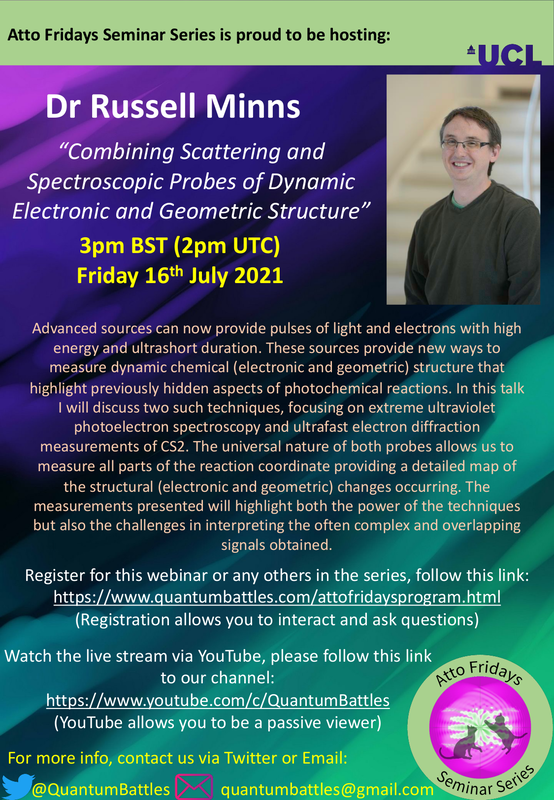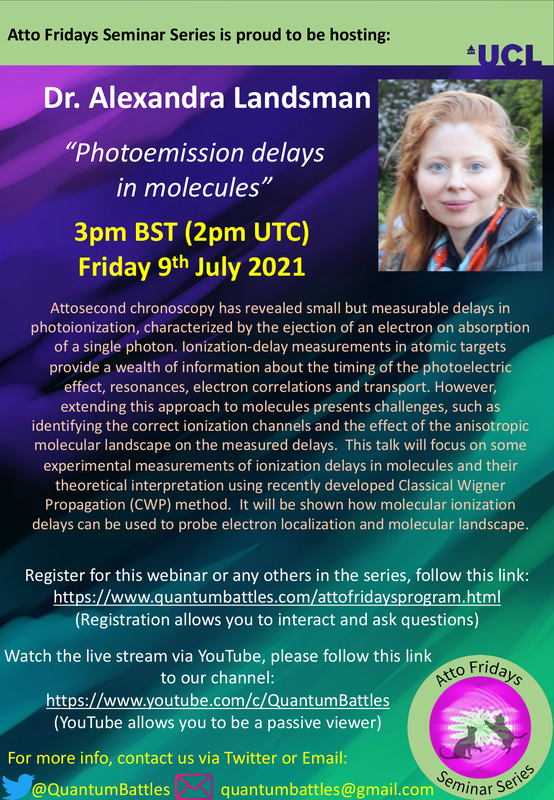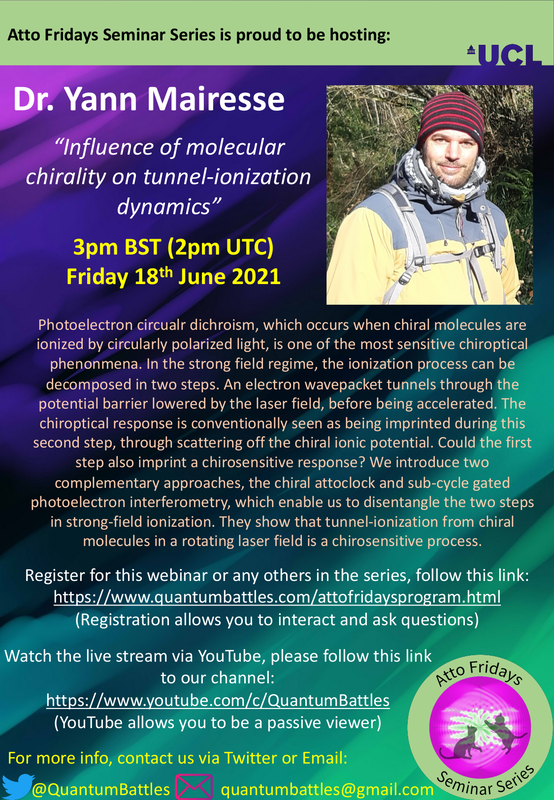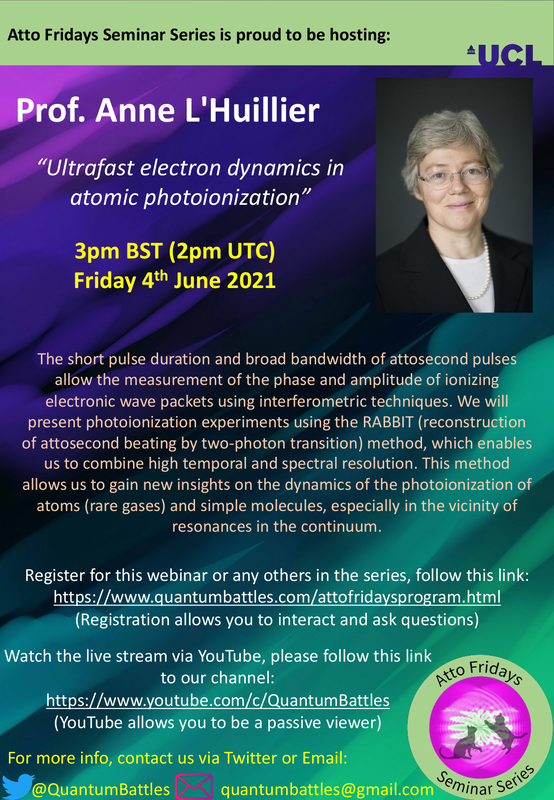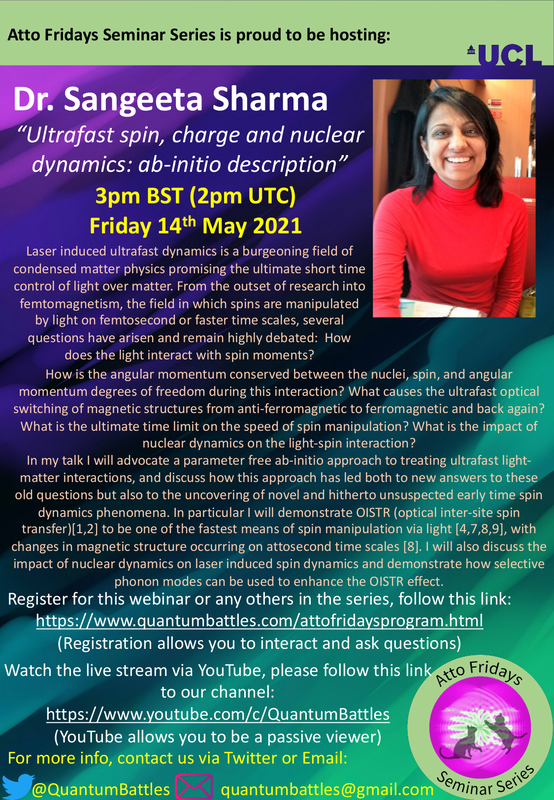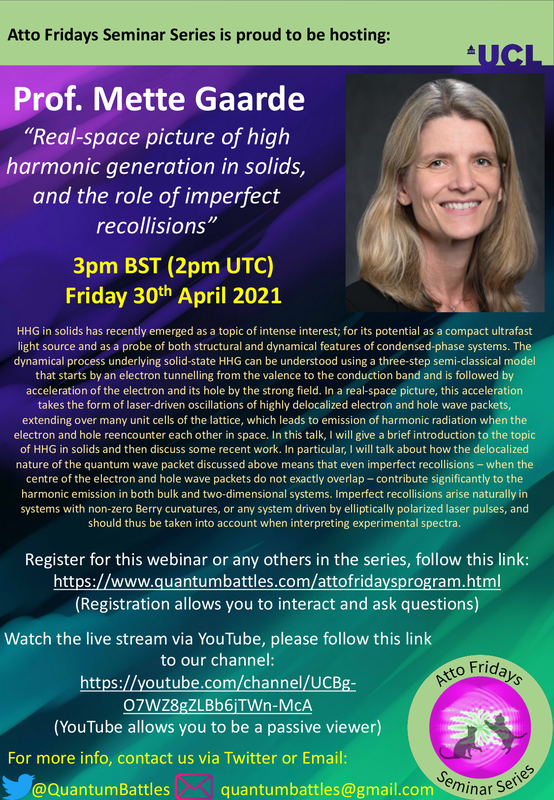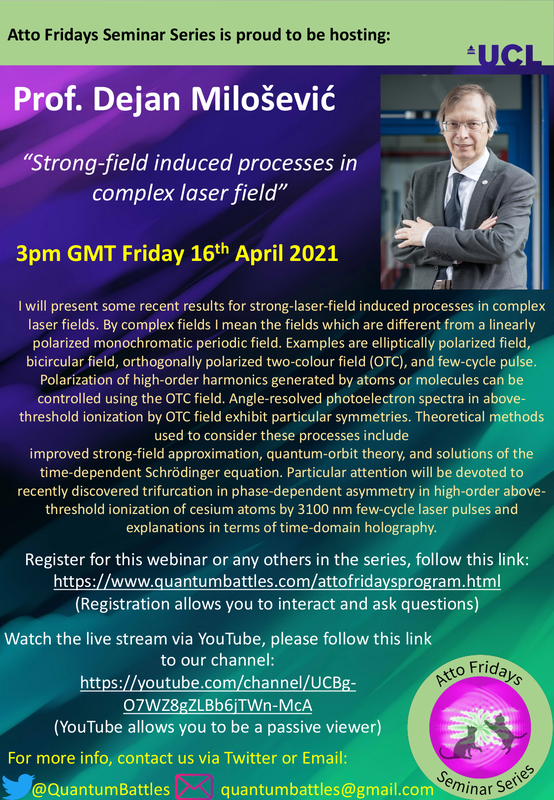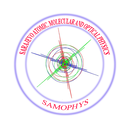Gallery of Speakers
Find the programme of all our upcoming speakers and their details here:
|
Prof. Ignacio Franco is an associate professor at the University of Rochester. Research in the Franco group focuses on theory and computation as it applies to dynamical processes occurring in molecules, nanoscale and extended systems. The group is particularly interested in exploring quantum frontiers in molecular science, and in developing new methods to probe and control the behavior of matter by means of external stimuli, a topic that they like to refer to as “Molecules Under Stress”. Ignacio received his B.Sc. in chemistry from the National University of Colombia in 2001. In 2002, after completing the diploma program in condensed matter physics at The Abdus Salam International Centre for Theoretical Physics in Trieste, he moved to the University of Toronto to pursue a Ph.D. in theoretical chemical physics under the guidance of Paul Brumer. In 2008 he joined Northwestern as a postdoctoral fellow in the groups of Mark A. Ratner and George C. Schatz. In 2011, he moved to Berlin to take a position as group leader and Humboldt research fellow in the Theory Department of the Fritz Haber Institute. In 2013, he joined the chemistry faculty as an assistant professor and was promoted to associate professor in 2019 and to full professor in 2024. Ignacio is the recipient of the NSF CAREER Award, the OpenEye Outstanding Junior Faculty Award of the American Chemical Society, the Leonard Mandel Faculty Fellowship, the Curtis Provost Teaching Award for Nontenured Faculty and the College Award for Undergraduate Teaching and Mentoring.
|
Past Speakers:
Click on the name of a speaker to directly jump to their details including the recording of their talk:
2023 Fall Semester
Mary Mathews - Takashi Tanaka - Alexis Chacon - Sivarama Krishnan
2023 Spring Semester
Donna Strickland - James Cryan - Adriana Palffy-Buss
2022 Fall Semester
Xinyao Liu - Antonia Freibert - Simon Brennecke - Eva Lindroth - Hamed Merdji - Eleftherios Goulielmakis - Mohammed Hassan - Morgane Vacher - Héloise Chomet - Karl Michael Ziems
2022 Spring Semester
Marzena Szymanska - Balázs Major - Kathryn Hamilton - Laura Cattaneo - Matteo Lucchini - Alba de las Heras Munoz - Emil Zak - Christian Ott - Himadri S. Chakraborty - Giuseppe Sansone - Andrew Maxwell
2021 Fall Semester
Francesca Calegari - Camilo Ruiz Mendez - Misha Ivanov - Philip Bucksbaum - Nirit Dudovich - Olga Smirnova - Rebecca Ingle
2021 Spring Semester
Francoise Remacle - Alicia Palacios - Dejan Milosevic - Marcelo Ciappina - Mette Gaarde - Maciej Lewenstein - Sangeeta Sharma - Shambhu Ghimire - Fernando Martin - Anne L'Huillier - David Ayuso - Yann Mairesse - Boris Bergues - Jens Biegert - Alexandra Landsman - Russell S Minns - Adam Kirrander - Gopal Dixit
2023 Fall Semester
Mary Mathews - Takashi Tanaka - Alexis Chacon - Sivarama Krishnan
2023 Spring Semester
Donna Strickland - James Cryan - Adriana Palffy-Buss
2022 Fall Semester
Xinyao Liu - Antonia Freibert - Simon Brennecke - Eva Lindroth - Hamed Merdji - Eleftherios Goulielmakis - Mohammed Hassan - Morgane Vacher - Héloise Chomet - Karl Michael Ziems
2022 Spring Semester
Marzena Szymanska - Balázs Major - Kathryn Hamilton - Laura Cattaneo - Matteo Lucchini - Alba de las Heras Munoz - Emil Zak - Christian Ott - Himadri S. Chakraborty - Giuseppe Sansone - Andrew Maxwell
2021 Fall Semester
Francesca Calegari - Camilo Ruiz Mendez - Misha Ivanov - Philip Bucksbaum - Nirit Dudovich - Olga Smirnova - Rebecca Ingle
2021 Spring Semester
Francoise Remacle - Alicia Palacios - Dejan Milosevic - Marcelo Ciappina - Mette Gaarde - Maciej Lewenstein - Sangeeta Sharma - Shambhu Ghimire - Fernando Martin - Anne L'Huillier - David Ayuso - Yann Mairesse - Boris Bergues - Jens Biegert - Alexandra Landsman - Russell S Minns - Adam Kirrander - Gopal Dixit
|
Prof. Xiaojun Liu is a Group leader at the Innovation Academy for Precision Measurement Science and Technology (APM), Chinese Academy of Sciences (CAS). He received his PhD from Chinese Academy of Sciences in 2000. After spending several years of academic visiting and PostDoc research at Imperial College (London), Max-Born-Institute (Berlin) and Texas A&M University (College Station), respectively, he became a PI in 2006 to lead the Ultrafast Science Group at APM. His current research topic includes: Ultrafast dynamics of atoms and molecules; Extreme ultraviolet (XUV) frequency comb and its applications; Optical multi-dimensional coherent spectroscopy and its applications.
|
Please note that the speaker has requested to keep the video private.
|
|
Dr. Attila Czirják is a research fellow in the theoretical strong-field and attosecond physics Theory and Simulations Group at ELI-ALPS and an honorary associate professor in the Dept. of Theoretical Physics at the University of Szeged. He studied an MSc in Physics at the Attila József University in Szeged before studying at the University of Ulm on a DAAD Jahresstipendium, including a short but important visit to Wilhelm Becker’s group at MBI Berlin. Back in Hungary, at the University of Szeged, he completed a PhD in Physics with a thesis on “Wigner functions in Quantum Optics”. Before joining ELI-ALPS, he worked for several years as a software engineer at Siemens and then as a research fellow in theoretical physics at the University of Szeged. He is a member of the Public Body of the Hungarian Academy of Sciences and the Roland Eötvös Physical Society and has Supervised numerous PhD, MSc and BSc students.
|
|
|
Dr Andrew Brown is a Reader in Theoretical Physics at the Centre for Light-Matter Interactions at Queen's University Belfast, and holder of a Research Software Engineering fellowship from UK Research and Innovation. His physics research focuses on the development and application of the R-matrix with time-dependence (RMT) theory and associated high-performance computer codes to problems in attosecond science. His Research Software Engineering fellowship focuses on developing new tools and practices for sustainable software development in atomic, molecular, and optical physics. He shares his home office space with his three daughters, who will probably make an appearance in the background of his Attofridays talk.
|
|
|
Prof. Katalin Varjú is the Science Director of ELI ALPS, responsible for the implementation and operation of the facility. She has been engaged with the ELI programme since 2008. Katalin also holds an associate professorship at the University of Szeged. Her main research interests are in optical, atomic physics, and attosecond scienceo
|
|
|
Prof. Linda Young is a researcher in x-ray science at UChicago and Argonne National Laboratory, where she is a Distinguished Fellow and leads the AMO Physics Group. Her group uses primarily accelerator-based light sources (x-ray free-electron lasers and synchrotrons) to understand x-ray interactions with matter from the linear to non-linear regimes. The recent development of synchronized two-color attosecond x-ray pulses with microjoule energies allows to initiate and probe radiation-induced processes on their natural time and length scales. She obtained her bachelor’s degree from MIT and Ph.D. from UC Berkeley. She has served as X-ray Science Division Director of the Advanced Photon Source, Chair of the Division Atomic, Molecular and Optical Physics of the APS, is a Fellow of the APS and has been a recipient of a Helmholtz International Fellowship and an honorary doctorate from Uppsala University.
|
|
|
Prof Sivarama Krishnan is currently Associate Professor at the Indian Institute of Technology Madras, Chennai, India. He is associated with the Quantum Center for Diamond and Emerging Materials and the Department of Physics, there. He also holds a visiting position at the Max Planck Institute fuer Kernphysik (MPI-K), Heidelberg. Earlier, he held a post-doctoral position at the Tata Institute of Fundamental Research (Hyderabad) and research scientist at IBM - Semiconductor R&D Center. He graduated with a Ph.D. from the MPI-K, Heidelberg. He is passionate about teaching physics and optics to young students, particularly to build indigenous experimental setups, and communicating aspects of science to broad audiences.
|
|
|
Dr. Alexis Chacon obtained Ph.D. at Universidad de Salamanca under the supervision of Prof. C. Ruiz and Prof. L. Plaja. He specialized in the physics of electron wavepacket characterization via attosecond quantum interferometry. His 1rst-P.D. was done atICFO in the Quantum Theory group ofProf. M.Lewenstein.Afterward, he joined the LANLto investigatethe topological phases and transitions of matterusing nonlinear optical responses, in whichAlexis, joint to SLAC-SU the theo-retical-experimental realization of featuring 3D topological insulators at the surface stateswas ob-served.BetweenOctober 2019—Dec 2022, he wasGroup Leader at MPI-Korea. Since Jan 2023 he is research Professor at the group of Prof. Jonghwan Kim at POSTECH University
|
|
|
Dr Matthews started her career combining solid state physics and ultrafast science, having completed first a MSc in Optics and Photonics and then a PhD on 2D heterostructures at Imperial College (IC). She was received the Marie Heim Voigtlin award while at the University of Geneva, as well as two NCCR-MUST awards. She returned to Imperial College, receiving a Royal Society University Research Fellowship in 2019 to study the emerging field of high harmonic generation in solids, and was appointed as a lecturer in Ultrafast Science shortly after. Her research activities have grown to include studies on laser filamentation in water, ultrafast X-ray spectroscopy on organic polymers, (with Jon Marangos), liquid scattering under strong field conditions, and high harmonic generation in nano-aerosols in collaboration with Ruth Signorell (ETH Zurich) and UVC generation using strong fields. Each project is underpinned by techniques in ultrafast laser sources, strong field interactions (e.g. HHG) in different media, and time resolved spectroscopy experiments.
|
Please note that the speaker has requested to keep the video private.
|
|
Dr. Takashi Tanaka is a Group Director in RIKEN SPring-8 Center. He received his PhD from Kyoto University in 1997 and joined in SPring-8, a synchrotron radiation (SR) facility in Japan for the development of undulators, one of the key elements in SR facilities. He also conducted the development of undulators in SACLA, an X-ray free electron laser (XFEL) facility in SPring-8, and became a PI in 2013 to lead the Advance X-ray Laser Group. Since then his resarch focuses on the advancement of XFEL including theoretical and experimental studies toward the generation of attosecond pulses in FELs.
|
|
|
Prof. James Cryan is a Staff Scientist at SLAC National Accelerator Laboratory. He is the head of the AMO Sciences Department at LCLS, and he is a member of the Stanford PULSE Institute, where leads the attosecond science group. James' research focuses on studying electron dynamics on the attosecond time scale and developing tools to better probe these phenomena. James is also the lead instrument scientist for the time-resolved molecular and optical sciences (TMO) hutch at the LCLS, a soft x-ray spectroscopy hutch which specializes in gas phase samples.
James completed his undergraduate education at The Ohio State University. He received his PhD in physics from Stanford University in 2012. From 2012 to 2014, James was a Postdoctoral scholar in the Chemical Sciences Division at Lawrence Berkeley National Laboratory. In 2015 he joined SLAC as a Staff Scientist in the Stanford PULSE Institute. In 2012, James won the Spicer Young Investigator award for his thesis work at the LCLS. In 2020, James was elected a fellow to the American Physical Society. |
|
|
Dr. Donna Strickland is a professor in the Department of Physics and Astronomy at the University of Waterloo and is one of the recipients of the Nobel Prize in Physics 2018 for developing chirped pulse amplification with Gérard Mourou, her PhD supervisor at the time. They published this Nobel-winning research in 1985 when Strickland was a PhD student at the University of Rochester.
Strickland earned a B.Eng. from McMaster University and a PhD in optics from the University of Rochester. Strickland was a research associate at the National Research Council Canada, a physicist at Lawrence Livermore National Laboratory and a member of technical staff at Princeton University. In 1997, she joined the University of Waterloo, where her ultrafast laser group develops high-intensity laser systems for nonlinear optics investigations. She was named a 2021 Hagler Fellow of Texas A&M University and sits on the Growth Technology Advisory Board of Applied Materials. Strickland served as the president of the Optica (formerly OSA) in 2013 and is a fellow of Optica, SPIE, the Royal Society of Canada and the Royal Society. She is an honorary fellow of the Canadian Academy of Engineering and the Institute of Physics, an international member of the US National Academy of Science and member of the Pontifical Academy of Science. Strickland was named a Companion of the Order of Canada. |
Please note: Due to the host agreement with Professor Strickland's media team, we are not allowed to keep the talk's livestreaming on our YouTube channel.
|
|
Dr. Xinyao Liu post doc at The Institute of Photonic Sciences. A general difficulty for diffraction-based imaging methods is the necessity to extract the molecular configurations from the measured diffraction patterns, which relies on identifying a global extremum in a multi-dimensional solution space. We establish the Machine Learning based laser-induced electron diffraction framework to overcome these issues and retrieve the atomic position of 1D, 2D and complex 3D chiral molecules with combined picometre and attosecond resolution.
Antonia Freibert, PhD student jointly supervised by Nils Huse (University of Hamburg, Germany) and Oriol Vendrell (Heidelberg University, Germany). Former UCL Master student. My main research interest is simulating non-adiabatic dynamics of excited molecular systems in order to describe time-resolved X-ray spectroscopy. Simon Brennecke, PhD student in the group of Manfred Lein at Leibniz University Hannover, Germany. The quantitative modeling of interference in photoelectron momentum distributions in terms of electron trajectories is of huge interest as it has important implications for the interpretation of strong-field holography as an ultrafast tool to study atoms and molecules. In order to account for focal-point effects like Gouy's phase anomaly, a rigorous implementation of the semiclassical approximation is needed and, hence, the inversion problem (mapping from final momenta to initial conditions) must be solved. For various different geometries of laser field and ionizing target, this cumbersome task can be tackled by means of clustering algorithms. |
|
|
Dr. Hamed Merdji after a PhD at Ecole Polytechnique on X-ray absorption spectroscopy in laser-plasma fusion in 1998, he started a post-doc in the Group of Bertrand Carré at CEA Saclay. He then joined the group as an associate-researcher to collaborate with Pascal Salières in pioneering attosecond pulse generation and characterization in atoms and molecules, evidencing the atto-chirp in 2003 and molecular quantum interferences in the attosecond phase of the harmonic emission of N2 in 2007. He was in 2007-2009 visiting physicist at Stanfdord invited by Phil Buckbaum to contribute to the Ultrafast Pulse Institute and free electron laser attosecond science. Back to France, he created the Ultrafast NanoPhotonics group and brought contribution in lensless imaging approaches using unconventional sources of light: from partial coherence to attosecond broadband time structure. In 2020, he has opened a new lab facility, NanoLight dedicated to high harmonic generation in semiconductors with a specific emphasize on light-matter interaction at a nanoscale for the generation of beams carrying spin or orbital angular momentum and nanoscale imaging of transient processes. In March 2022, he moved to Ecole Polytechnique (24 years after the PhD, back to the origins! From 1 shot every 2 hours in 1998 to 20 million shots per second in 2022!!!). His interest is now to study entanglement in high harmonic generation to explore new quantum diffractive imaging schemes.
|
|
|
Prof. Eleftherios Goulielmakis is a Greek physicist and a university professor in the field of attosecond physics. After graduating from the southernmost high school of Europe, he studied physics at the University of Crete, and he acquired his degree in physics in 2000, and a master degree in optoelectronics (2002). He received his doctorate in physics (2005) from Ludwig's Maximilian University of Munich with a thesis on the characterisation of light waves using attosecond pulses. Later he worked as a postdoctoral researcher at the Max Planck Institute of Quantum Optics in Garching Germany. From 2010 to 2018 he led the activities of the research group “Attoelectronics” at the same institute. In 2010, he also took on an associate professorship at POSTECH in Korea, where he coordinated the Max Planck Center for Attosecond Research. Since 2018, Prof. Goulielmakis has been the head of the research group "Extreme Photonics" at the University of Rostock.
Goulielmakis is best known for his work on attosecond physics, in particular, the first direct measurement of the the field of light waves using the technique now broadly known as “attosecond streaking”. His group has been the first to realize optical attosecond pulses using the technique of light-field synthesis and to use this tool for studying ultrafast and strong-field phenomena in atoms and solids. For his work on the attosecond control and synthesis of light waves he has been awarded the Georgios Foteinos Prize of the Academy of Athens in 2007, the International Union of Pure and Applied Physics Young Scientist Prize in Optics of the International Commission for Optics in 2009, the Gustav Hertz Prize of the German Physical Society (DPG) in 2013, and the Röntgen Prize of the Justus-Liebig-University of Giessen in 2015. |
|
|
Prof. Mohammed Hassan is an Assistant Professor of Physics and Optical Sciences at The University of Arizona (UA). He has 13 years of experience in the Attosecond Physics and Ultrafast Electron Microscopy and imaging research fields. He earned his Ph.D. from Max-Planck Institute for Quantum Optics, Munich, Germany, Prof. Ferenc Krausz group in 2013. He joined Prof. Ahmed H. Zewail’s group at Caltech as a postdoctoral scholar through 2017. Earlier in his career, Dr. Hassan developed the light field synthesizer to generate the first optical attosecond pulse, the shortest light pulse documented in the Guinness World Records. Exploiting this tool, he measured the time an electron takes to respond and move. His breakthroughs have been published in high-profile journals.
He is currently well known in his field of attosecond Physics for developing the attosecond electron microscopy “Attomicroscopy”, a camera that will film the electron motion in action. He used this tool to image the electron motion in the solid state. This electron imaging opens a new era in ultrafast electron imaging and will lead to many breakthroughs and high-impact scientific achievements. Attomicroscopy imaging opens a new window to the quantum world. Recently, he has granted a patent for his Attomicroscopy camera, US Patent, Application No.16394920. Furthermore, he established a new methodology to sample the light field of ultrafast laser pulses and a new methodology to measure the electronic delay response in the neutral matter. Also, he demonstrated the attosecond optical switch and the capability to encode data on ultrafast laser pulses, which paves the way to establish attosecond and femtosecond optoelectronics working at the petahertz speed. |
|
|
Dr. Morgane Vacher obtained her Ph.D. degree in theoretical and computational chemistry in 2016 from Imperial College London (UK), supervised by Profs. Mike Robb and Mike Bearpark. She worked then as a postdoctoral researcher at Uppsala University (Sweden), within the group of Prof. Roland Lindh. Since late 2019, she was appointed as a CNRS researcher within the CEISAM laboratory in Nantes (France). Her research interests include theoretical photochemistry and non-adiabatic dynamics of molecular excited states using direct ab initio methods, and the application of attosecond science to chemistry. She was awarded in 2020 with the Etoile Montante research grant from the Region Pays de la Loire. She was a member of the 2021 Early Career Advisory Board of JACS Au. She was recently awarded an ERC Starting grant with the ATTOP project beginning late 2022.
|
|
|
Héloise Chomet is a PhD student in the group of Prof. Carla Figueira de Morisson Faria.
Karl Michael Ziems is a PhD Student inTheoretical Chemistry at the Friedrich-Schiller University Jena, Germany. He studied (theoretical) chemistry in Germany (Jena) and England (Oxford) and did research stays in computational chemistry (Prof. Neese, MPI Kohlenforschung, Germany) and computational physics (Prof. Schwingenschlögel, KAUST, Saudi Arabia). During his PhD, he is combining tools and models from theoretical physics and chemistry to understand fundamental processes for attosecond chemistry. |
|
|
Prof. Marzena Szymanska is a theoretical physicist exploring emergent phenomena in far from equilibrium quantum systems, especially quantum fluids of light. She obtained her PhD from Cambridge (2002), held Research Fellowships at Cambridge and Oxford Colleges (2002-2007), EPSRC post-doctoral Fellowship in Oxford (2005-2007) before moving to Warwick as a Lecturer in 2007. She joined Physics and Astronomy Department at UCL in 2013, where she is now a Professor and the ESPRC fellow.
|
|
|
Dr. Balázs Major is Senior Research Fellow at the Extreme Light Infrastructure Attosecond Light Pulse Source (ELI ALPS) leading the High repetition-rate attosecond sources group, and is an Assistant Professor at the University of Szeged. He obtained his PhD at the same university in 2017, with a thesis on theoretical and experimental analysis of phase- and polarization changes of ultrashort laser pulses upon focusing. In parallel he got involved in the activities of the research group of Katalin Varjú, focusing on optimization of attosecond pulse sources based on high-harmonic generation in gases. After PhD studies he joined the team of ELI ALPS, in the first years visiting different groups as a guest researcher in Europe, for example at Lund University, the Max Born Institute (Berlin) and Institut Lumière Matière (Lyon). Since 2020 he has been leading the development, operation and research activity of two attosecond beamlines at ELI ALPS. In 2021 the Editorial Board of Journal of Physics B has selected him as an emerging leader of AMO science, and from this year he is chairing the Short Wavelength Sources and Attosecond/High Field Physics Technical Group of Optica.
|
|
|
Dr. Kathryn Hamilton is a Postdoctoral Research Scholar at Drake University in Des Moines, Iowa, where she works alongside Prof. Klaus Bartschat on applying R-Matrix methods to treat a variety of atomic physics problems. She obtained her PhD in 2019 under the supervision of Dr. Andrew Brown and Prof. Hugo van der Hart at Queen’s University Belfast with a thesis entitled “R-Matrix calculations for ultrafast two-colour spectroscopy of noble gas atoms”. Her current research focusses on observing and controlling multielectron dynamics in atoms exposed to external laser fields, and electron collisions with atomic species. This fall she will take up a position as an Assistant Professor of Physics at the University of Colorado at Denver. When she is not running code on supercomputers all over the world, she likes to play traditional Irish music and domesticate feral cats. Both activities produce very similar sounds.
|
|
|
Dr. Laura Cattaneo. I completed my PhD (2009-2011) in experimental physics at the Politecnico di Milano (Italy) entirely dedicated to the fabrication and characterization of different types of nanomaterials: thin films, nanowires and nanoparticles. I continued with my first postdoc in the Spectroscopy of Solids and Interfaces group at Radboud University in Nijmegen (The Netherlands), from 2011 to 2014, working on the optical properties of liquid crystal (LC) within an International Training Network (ITN) project and in collaboration with both academic and industrial partners, such as Philips and Merck. In 2014 I started a new postdoc experience in the group of Ultrafast Laser Physics at ETH Zurich (Switzerland), working on dynamical processes at the shortest time scales, namely attosecond, in atomic and molecular targets. Since May 2020 I am running my own group named ‘Ultrafast Liquid Crystal Dynamics’ (ULCD) as an independent Max-Planck Research Group Leader at the Max Planck Institute in Heidelberg, where I am trying to ‘look’ at liquid crystal from an ultrafast point of view, a benchmark study to expand towards the soft matter world.
|
|
|
Dr. Matteo Lucchini is Senior Assistant Professor by the Physics Department of Politecnico di Milano. He studied Engineering Physics at the Politecnico di Milano where he graduated in December 2008. He obtained a PhD in Physics cum laude at the same institute in March 2012 with a thesis on the development of new techniques for the generation of single attosecond pulses and their application to molecular dynamics. In the same year, he joined the the Ultrafast Laser Physics Group, Eidgenössische Technische Hochschule (ETH), led by with Prof. Ursula Keller, where he was awarded an ETH Zurich postdoctoral fellowship (Marie-Curie cofunded) and devoted his efforts to transfer attosecond techniques in solid targets for the study of electron dynamics. In particular, he worked on photoemission dynamics from noble metals like copper, silver and gold, studying the formation of phenomena like screening and effective mass with sub-femtosecond resolution. He also performed attosecond transient absorption spectroscopy to study strong-field Physics in dielectrics like diamond and gallium arsenide. In 2017 he became junior assistant professor at Politecnico di Milano and in 2019 he has been awarded the price Alfredo di Braccio for young Italian physicist and the Fresnel price by the European Physical Society for outstanding contributions in the field of Attosecond Science. In 2021 he has been awarded the prize “Antonio Feltrinelli Giovani" for a researcher in Physics under the age of 40. At present, Matteo is in charge of the scientific activity performed at the attosecond laboratories at Politecnico di Milano where he is PI of the ERC-STG project AuDACE (No. 848411), which aims at studying the very first instants of light-matter interaction with attosecond laser pulses in advanced materials.
|
|
|
Alba de las Heras Munoz is a PhD student at the University of Salamanca, in the research group of Laser Applications and Photonics. Graduated in Physics (2018) and Master in Laser Physics and Technology (2019) at the University of Salamanca, with an international stay at the University of Bristol. President of the Optica Student Chapter in Salamanca. Active member of the Committee on Women in Optics and Photonics of the Spanish Society of Optics. Board member of the Committee of Quantum Optics and Nonlinear Optics in the Spanish Society of Optics and in the Royal Spanish Society of Physics. I work on theoretic research in Nonlinear Optics and Atomic Physics, with a particular focus on high-order harmonic generation, multielectron dynamics and structured light.k here to edit.
Dr. Emil Zak received his PhD in Theoretical Physics (2017) from University College London. Under the supervision of Jonathan Tennyson, Emil’s research covered theoretical rotational-vibrational and rotational-vibrational-electronic spectroscopy of triatomic molecules. After completing his PhD he became a Postdoctoral Fellow at Queen's University in Kingston, Ontario, Canada (2018-2019) where he worked with Tucker Carrington on the computational methods development in quantum dynamics of molecules. Most recently (2019-2022) he was a Research Associate at the Center For Free-Electron Laser Science (CFEL) in the Deutsches Elektronen-Synchrotron DESY in Hamburg, Germany. As a member of the controlled molecule imaging group he conducted calculations of ultrafast dynamics of molecules in laser fields. Emil’s present research aims to uncover the dynamical aspects of chirality, emerging at the attosecond time-scales. He simulates interactions of chiral molecules with chiral electromagnetic fields. |
|
|
Dr. Christian Ott is staff scientist and group leader at the Max Planck Institute for Nuclear Physics in Heidelberg, Germany, in the Division “Quantum Dynamics and Control”, working with Prof. Thomas Pfeifer. Christian received his doctoral degree in 2012 from Heidelberg University on attosecond interferometric techniques and strong-field control of two-electron dynamics. During his two years postdoc with Profs. Stephen Leone and Daniel Neumark at the University of California at Berkeley, USA, he studied strongly correlated materials by means of attosecond transient absorption spectroscopy, sponsored by a Feodor Lynen postdoctoral fellowship of the Alexander von Humboldt foundation. Christian is leading research efforts which include the fundamentals of absorption spectroscopy, resonant light-matter interaction and few-electron dynamics in small atoms and molecules and their ultrafast control, employing both lab-based (lasers & HHG) and large-facility (FEL) ultrafast light sources.
|
|
|
Professor Himadri S. Chakraborty is a Professor of Physics at the Department of Natural Sciences, Dean L. Hubbard Center for Innovation, and Loess Hills Research Center at Northwest Missouri State University, United States of America. Over 18 years of undergraduate/graduate teaching and research mentoring experiences in areas of nanoparticle/nano-surface physics, ultrafast AMO physics and charge-particle impact spectroscopy. Conferred with a prestigious Ingram’s award as “one of 50 Missourians you should know” in 2011 for contributions to the nanoscale science research and degree programs at the Hubbard Center, Northwest. Published about a hundred peer-reviewed articles in journals including Physical Review Letters, Physical Reviews, Journal of Physics (UK), the European Physics Journal and MDPI Journals. Serving in Atom MDPI Journal editorial board. Won half a dozen of the US National Science Foundation awards. Currently leading programs on ultrafast and positron/electron/ion-impact nonadiabatic relaxation and emission spectroscopies of atoms, biological molecules and fullerene materials funded by the US National Science Foundation. Lead a different program on electronic dynamics in nanostructured surfaces by ion-surface and adsorbate-surface interactions funded by the XSEDE supercomputer grants.
|
|
|
Professor Giuseppe Sansone was a visiting Scientist at the Max Planck Institute for Nuclear Physics, from 2009-2011. He was associate Professor in the Physics Department Politecnico Milano from 2014-2016. Since 2016 he has been a full Professor for Experimental Physics, at the University of Freiburg and in 2020 was awarded Innovation Award on Synchrotron Radiation 2020 Helmholtz-Zentrum Berlin. His research interests include Attosecond dynamics in atoms and molecules, Generation of ultrashort pulses and Free-electron laser science.
|
|
|
Dr Andrew Maxwell completed his undergraduate degree in 2014 at the University of Bristol and obtained his PhD in 2019 at University College London (UCL) with Prof. Carla Faria, this focused on interferences in single and double electron ionization in strong-field processes. After this, he did an EPSRC funded postdoctoral fellowship at UCL in the quantum science and technology institute (UCLQ), where he worked on quantum metrology in attoscience as well as photoelectron holography. In 2020, he went to ICFO-The Institute of Photonic Sciences with Prof. Maciej Lewenstein, investigating entanglement in orbital angular momentum and chirality in attoscience. Since this September, Andy has been a Marie Curie Individual Fellow at Aarhus University with Prof. Lars Bojer Madsen, investigating spin and orbital angular momentum in strong field systems.
|
|
|
Dr Rebecca Ingle is a Lecturer in Physical Chemistry at University College London. She completed her PhD at the University of Bristol with Professor Mike Ashfold before moving to EPFL, Switzerland for postdoctoral position with Professor Majed Chergui. Her research interests include the application and development of X-ray and optical spectroscopy methods for investigating complex chemical dynamics.
|
|
|
Prof. Olga Smirnova graduated from the Physics Department of the Moscow State University in 1996 and received her PhD there in 2000, continuing as assistant professor. In 2003 she received the Lise-Meitner Fellowship of Austrian Science Foundation (FWF) and joined the Vienna University of Technology as a postdoctoral fellow. In 2005 she moved to the National Research Council (NRC) in Ottawa, Canada, where she became a permanent staff scientist in 2006. In 2009 she received the SAW award of the Leibniz society and moved to the Max Born Institute to establish her own Strong Field Theory research group, which she continues to lead. Since 2016 she also holds full professorship at the Technical University Berlin. In 2010 Olga has received the Karl-Scheel-Preis of Physikalischen Gesellschaft zu Berlin and in 2020 she has received the Ahmed Zewail Award in Ultrafast Science & Technology of the American Chemical Society. Olga’s current research focuses on imaging and control of ultrafast electron dynamics in atoms, solid state materials, and molecules, especially chiral molecules.
|
|
|
Prof. Nirit Dudovich works at the forefront of laser physics and optics. She investigates ultrafast interactions between light and matter on a attosecond time scale. Her research links basic concepts from quantum control and applied math to attosecond science. Prof. Dudoich’s group has pioneered novel schemes for attosecond metrology and applied them to reveal fundamental ultrafast phenomena in nature
Prof. Dudovich earned a BSc in physics and computer science from Tel Aviv University in 1996. She received an MSc and PhD in physics from the Weizmann Institute in 1999 and 2004. In 2004 she received the Rothschild Fellowship for postdoctoral studies and joined the group Prof. Paul Corkum. In 2007 she joined the Weizmann Institute of Science and established the first research group for attosecond science in Israel. Prof. Dudovich is a recipient of a number of prestigious fellowships and awards, including the 2013 Krill Prize for Excellence in Scientific Research, the IPS Prize for Young Physicist in 2012, the IUPAP Young Scientist Prize in 2012, and the Weizmann award in 2021. She received the ERC Starting investigator grant (2015) and consolidator grant (2019). Prof. Dudovich was elected to the Young Israel Academy of Sciences and Humanities and in 2016, she was elected to be a Fellow of the American Physical Society (APS). |
|
|
Philip H. Bucksbaum is an atomic physicist. He holds the Marguerite Blake Wilbur Chaired Professorship in Natural Science at Stanford University, with appointments in Physics, Applied Physics, and in Photon Science at the SLAC National Accelerator Laboratory. He also founded and formerly directed the Stanford PULSE Institute (ultrafast.stanford.edu).
He studies the interaction of intense laser radiation with atoms and molecules, with an emphasis on interactions induced by femtosecond pulsed radiation and ultrashort (femtosecond and attosecond) x-ray lasers. Prior to coming to Stanford, Bucksbaum was on the faculty at the University of Michigan for sixteen years, where he held both the Peter Franken University Chair, and the Otto Laporte Collegiate Chair in Physics. From 1981 to 1990 he was a member of the scientific research staff at Bell Laboratories in New Jersey. He received his M.A. (1978) and Ph.D. (1980) degrees in Physics from the University of California at Berkeley, and his A.B. degree in Physics from Harvard College. He is a Fellow of the American Physical Society and Optica (formerly OSA) and has been elected to the National Academy of Sciences and the American Academy of Arts and Sciences. He was president of Optica in 2014 and president of the American Physical Society in 2020. |
|
|
Prof. Misha Ivanov has been doing intense light matter interaction for over 30 years, published well over 200 papers on this topic. He says "about 100 of them are pretty good". He received the Rutherford medal-physics from the Royal Society of Canada and the Wilhelm Bessel award from the A v Humboldt foundation. He likes good food and hates Twitter.
|
|
|
Prof. Camilo Ruiz is an associate professor at the Salamanca University at the Instituto de Física Fundamental y Matemáticas and the Faculty of Education.
He is a physicist, graduated from the UNAM in Mexico City, he got his PhD at the Salamanca University in strong laser interactions with few body systems and then went for a postdoc at the Max Planck Institute for Complex Systems in Dresden and later in the Imperial College. He got a Ramon y Cajal Fellowship to return to Spain where he helped to found the CLPU 1 PW laser center in Salamanca and the L2A2 50 TW laser lab in Santiago de Compostela. His current research interests are Attosecond science, Laser Driven Plasma Accelerators and the Education of Climate Change. He leads the research group EMC^3 at the Salamanca University. |
|
|
Prof. Francesca Calegari is an experimentalist specialised on attosecond pulse generation and attosecond spectroscopy of complex systems.
She got her PhD in Physics at the Politecnico di Milano, Italy, and did postdoctoral research at Politecnico, Max Planck Institut für Kernphysik in Heidelberg, Germany, FOM Institute AMOLF in Amsterdam, the Netherlands, CFEL in Hamburg Germany. After three years as an Adjunct Professor of Physics at Politecnico di Milano, she moved to Hamburg in 2016 as a Full Professor of Physics and Leading Scientist at DESY. She has received the LIGHT2015 Young Women in Photonics Special Recognizition from EOS and EPS, the ICO prize and the Ernst Abbe medal from the International Commission of Optics, among many other awards. |
|
|
Dr. Gopal Dixit:
After finishing Ph. D. from IIT Kharagpur in 2011, I joined center for free-electron laser science (CFEL), Hamburg Germany as a postdoctoral scientist. In 2013, I moved from Hamburg to Max-Born Institute (MBI) Berlin Germany. Currently, I am an associate professor in IIT Bombay, Mumbai India. I am also visiting scientist at MBI Berlin and MPI-PKS Dresden Germany. During Ph. D., I was a visiting student at TUM Munich under DAAD fellowship. |
|
|
Dr. Adam Kirrander is a Senior Lecturer at the University of Edinburgh and visiting scientist at Brown University. He completed his PhD with Professor Child at Oxford and was a postdoc with Professor Fielding at UCL before going to work with Dr Jungen in Paris as a Marie Curie fellow. Before moving to Edinburgh, he spent one year at ITAMP (Harvard-Smithsonian). His research focuses on theoretical aspects of new ultrafast imaging techniques and the possibility of real-time observation of chemical reactions.
|
|
|
Dr Russell Minns is an associate professor in the School of Chemistry at the University of Southampton. He obtained his PhD from UCL in 2005 under the supervision of Prof. Helen Fielding. Following postdoctoral positions at the University of Virginia and at UCL, he was awarded a Royal Society University Research Fellowship in 2011 and moved to the University of Southampton. In Southampton his research focuses on exploiting new optical technologies for studying complex chemical reaction dynamics in both the gas and solution phase.
|
|
|
Dr. Alexandra Landsman received her Ph.D. in 2005 from Princeton University and worked as a Marie Curie Senior Scientist at ETH Zurich, before moving to the Max Planck Institute for the Physics of Complex Systems in Dresden as a group leader. In 2019 she moved her group to Ohio State University and took on an Associate Professorship.
Her group studies the ensuing dynamics when ultrashort light shines on atoms, molecules and condensed matter systems. These ultra-short flashes of light are on a time scale of attoseconds (10^(-18) seconds) to femtoseconds (10^(-15) seconds), which is fast enough to capture the motion of bound electrons inside matter. To quote the 2018 Nobel Prize Physics website: “Extremely small objects and incredibly fast processes now appear in a new light.” The ultimate goal is accurate imaging and control of electron dynamics on the attosecond time-scale. They use a variety of numerical and analytic methods, ranging from the solution of the Schrodinger equation to classical and semiclassical approaches to techniques from nonlinear dynamical systems. |
|
|
Prof. Jens Biegert received his PhD in 2001 with distinction from the Technical University Munich and his work was awarded the Allen Prize of the Optical Society (OSA). He went on to head a research group on ultrafast pulse generation and strong field physics during his Habilitation at ETH Zurich from 2001 until 2006. Since 2007 as tenured Professor at ICFO and ICREA Professor of Attoscience and Ultrafast Optics, his research focus lies on the investigation of the real-time quantum dynamics of electrons and nuclei in atoms, molecules and solids.
Jens Biegert is actively involved in the scientific community as author of the Whitebook leading to the pan-European Extreme Light Infrastructure (ELI), is elected Chair of the General Assembly of Laserlab-Europe AISBL, member of the Management Board of Laserlab-Europe and Laserlab-Europe AISBL, Chair of the Board of Meetings and Member of the Meetings Council of The Optical Society (OSA), and traveling lecturer of The Optical Society (OSA). He holds an appointment as Adjunct Professor at the University of New Mexico in the USA, and as Guest Professor at the Fritz Haber Institute of the Max Planck Society at Berlin. He is Associate Editor of APL Photonics, Associate Editor of Ultrafast Science, received the Thousand Talents Program Award from the Government of China, is Fellow of the German Academic Scholarship Foundation, Fellow of Optical Society of America, and Fellow of the American Physical Society. He currently holds an ERC Advanced Grant, coordinates a FET Consortium and was awarded the Bessel Prize of the Alexander von Humboldt Foundation. |
|
|
Dr. Boris Bergues is a researcher at the Max Planck Institute of Quantum Optics (MPQ) and the Ludwig-Maximilians-University Munich (LMU). Born in Grenoble, France, he studied Physics at the University of Freiburg, Germany from which he received his Ph.D. in Physics in 2008. He then joined the MPQ as a postdoc. Since 2016, he leads the Strong-Field Dynamics team within the Ultrafast Imaging and Nanophotonics Group at the LMU and has strong connections with the National Research Council in Ottawa that he visited in 2018 for a year. His research focuses on light-matter interaction in atoms, molecules, solids, and nano-systems in different wavelength regimes. His experimental research is based on various time-resolved spectroscopy methods to image ultrafast electronic and molecular dynamics. Along the way, he has developed and improved several scientific instruments and techniques including ion microscopy, reaction nanoscopy, and various ultrafast field-sampling methods.
|
|
|
Dr. Yann Mairesse is a CNRS researcher at CELIA, Bordeaux, France. He generated his first attosecond pulses in 2000 as a summer student in Saclay but did not realize it, since there was no way to characterize attosecond pulses at the time. Soon after the first attosecond measurements in 2001, he started his PhD thesis in Bertrand Carré’s group in Saclay on the generation, characterization and optimization of attosecond pulses. He and his colleagues used the emerging RABBIT technique to measure the chirp of attosecond pulses in a train, transposed the SPIDER technique to characterize the femtosecond profile of high-harmonics, and introduced the FROG-CRAB method, which enables the complete characterization of arbitrary attosecond pulses.
Yann moved to Ottawa in 2005 as a postdoc in Paul Corkum’s group to work on high-harmonic spectroscopy of aligned molecules. He and his colleagues fully characterized the high-harmonic emission (amplitude, polarization, phase), and established that several molecular orbitals could contribute to high-order harmonic generation, revealing the underlying attosecond dynamics. Yann came back to France in 2007 and settled at CELIA in a research group combining experimentalists and theoreticians. Since then, they have been investigating the strong-field response and ultrafast dynamics of increasingly complex systems – atoms, diatomic molecules, polyatomic molecules, clusters. In the past few years, molecular chirality has become their main subject of interest. They have used multiple approaches to investigate the femtosecond and sub-femtosecond dynamics of chiral molecules, from chiral high-harmonic generation to time-resolved photoelectron circular dichroism. They have used strong-field spectroscopy to measure the attosecond dynamics underlying chiral photoionization, and to control the chiroptical interaction by tailoring the instantaneous chirality of light. |
|
|
Dr. David Ayuso:
I obtained my PhD from Universidad Autónoma de Madrid in Dec 2014, under the supervision of Alicia Palacios and Fernando Martín. My PhD focused on the theoretical modelling of molecular photoionization and ultrafast charge migration in biologically relevant molecules initiated by ultrashort laser pulses. In Jan 2015, I joined the group of Olga Smirnova at the Max-Born-Institut in Berlin. We have studied highly nonlinear phenomena driven by intense laser fields, such as spin-polarization in strong-field ionisation of noble gases and high harmonic generation in chiral molecules, and developed new ways of imaging molecular chirality on ultrafast time scales. Last year, I was awarded a University Research Fellowship (URF) from the Royal Society, which has enabled me to begin my own independent research at Imperial College London. My URF project aims to develop new optical methods for ultrafast and highly enantio-sensitive imaging and control of molecular chirality. |
|
|
Prof. Anne L'Huillier is a Swedish/French researcher in attosecond science. She defended her PhD thesis at the Université Pierre et Marie Curie, Paris, in 1986. She was employed as researcher at the Commissariat à l'Energie Atomique, in Saclay, France until 1995. She moved to Lund University, Sweden and became full professor in 1997. Her research has been centred on the process of high-order harmonic generation in gases. Currently, her group works on attosecond source development and optimization as well as on applications, e.g. the measurement of photoionization dynamics in atomic systems.
|
|
|
Prof. Fernando Martín is Full Professor at the Universidad Autónoma de Madrid since 2005. His research focuses on light-atom and light-molecule interactions, and the properties of new materials and nanoobjects. In 2000, he was awarded the National Research Prize Rey Juan Carlos I, in 2010, the prize of the Spanish Royal Society of Chemistry in Chemical Physics, in 2011, the Advanced Grant from the European Research Council XCHEM, in 2017 the Prize Rey Jaime I in Basic Research, and in 2020 the Synergy Grant from the European Research Council TOMATTO. He is currently the coordinator de the European COST Action AttoChem.
|
|
|
Dr. Shambhu Ghimire is a Lead Scientist and a Principal Investigator at Stanford PULSE Institute, SLAC National Accelerator Laboratory. He is a recipient of the prestigious Young Investigator award from the U.S. Department of Energy (2014-2019). His research interests are on Strong-field Quantum Physics and Nonlinear X-ray Science. He received his Ph.D. in physics from Kansas State University in 2007 and went to University of Michigan for a post-doc job before he joined Stanford in 2009. More about his journey can be found in this link.
|
|
|
Dr. Sangeeta Sharma did her PhD in India (in 2000), in indian institute of technology - Roorkee. After that she joined Uppsala Sweden as a post-doc. Then Graz Austria, where she together with her husband (Dr. Kay Dewhurst) started to work on the Elk code. Which is now one of the most precise electronic structure code and is being used by 2000+ people around the world. After Graz Sangeeta moved to Germany (in 2005) and has been in Germany ever since. She was group leader at MPI Halle with Prof. E. K. U. Gross. Since 2018 she is head of condensed matter theory group in MBI-Berlin.
Research interests: Electronic structure, functional theories, ultrafast spin and charge dynamics and fully ab-initio treatment of mesoscopic, long length scale physics. |
|
|
Prof. Maciej Lewenstein (Warsaw 1955) graduated at Warsaw University in 1978. He joined the Centre for Theoretical Physics of the Polish Academy of Sciences in Warsaw, where he remained for 15 years, becoming a professor in 1993. He finished his PhD in Essen in 1983 and habilitated in 1986 in Warsaw. He has spent several long term visits at Universität Essen, at Harvard University with Roy J. Glauber (Nobel 2005), at Commisariat a l'Énergie Atomique in Saclay and at Joint Institute for Laboratory Astrophysics at Boulder. He was on faculty of CEA in Saclay (1995-1998), of the Leibniz University Hannover (1998-2005). In 2005 he moved to Catalonia as ICREA Research Professor to lead the quantum optics theory at the Institut de Ciències Fotòniques in Castelldefels. His interests include quantum optics, quantum physics, quantum information, many body theory, atto-second science, and statistical physics. His other passion is jazz and avant-garde music - he is an acclaimed jazz writer and critic, author of “Polish Jazz Recordings and Beyond”. At ICFO Maciej Lewenstein leads a 25 people team working on the mentioned subjects. He published more than 600 papers, reviews, book articles/conference proceedings, and 6 books. His works were cited over 39500 times with H-index 100. He is a recipient of many national and international prizes, including the Polish “Nobel” – the Prize of Fundacja Nauki Polskiej, Hamburg University Theory Prize, Johannes Gutenberg Prize of University of Mainz, EPS Quantum Optics and Electronic Prize, or Willis Lamb Prize. He is a foreign member of the Polish Academy of Sciences and a member of European Academy of Science and Academia Europea. He is the recipient of 3 ERC Advanced Grants, and Highly Cited Researcher in 7 consecutive years 2014-2020.
|
|
|
Prof. Mette Gaarde is the Les and Dot Broussard Alumni Professor of Physics at Louisiana State University. She received her Ph.D. from Copenhagen University in Denmark, with much of her graduate and post-doctoral work performed at Lund University in Sweden. She is a Fellow of both the APS and the OSA, and is currently serving as Vice Chair of APS-DAMOP.
|
|
|
Prof. Marcelo Ciappina:
I received my PhD in Physics from the Balseiro Institute, Argentina in 2005 and a Research Professor degree from the Czech Academy of Sciences in 2019. My academic training includes postdoctoral stays and senior positions in renowned institutions from Germany, Singapore, USA, Spain and Czech Republic. At present I am Associate Professor at the Guangdong-Technion Institute of Technology (GTIIT), Shantou, China. My areas of interest include attosecond science and atomic collisions. In my free time I enjoy listen to 80s music. I also love to run and travel. |
|
|
Prof. Dejan Milošević:
I am a full professor of theoretical physics at the Faculty of Science, University of Sarajevo. My main areas of research are atomic and molecular processes in strong laser fields and attoscience. I am the only physicist who is a full member of the Academy of Sciences and Arts of Bosnia and Herzegovina. I am also a member of the European Academy of Sciences and Arts. From numerous awards I got for my achievements I emphasize: The individual Sixth of April Award of the City of Sarajevo which the highest decoration given by the city of Sarajevo, and the Georg Forster Research Award by the Alexander von Humboldt Foundation. I am a founder of Samophys – Sarajevo Atomic, Molecular and Optical Physics research group, which has the following logo: |
|
|
Born in Tomelloso, Spain, in 1979. Dr. Alicia Palacios received the Graduate degree in Chemistry in 2001 and the Ph.D. degree in 2006 both from the Universidad Autónoma de Madrid, Spain. Several stays at the Université Bordeaux I, and a long-term Postdoctoral fellowship (2006–09) in Lawrence Berkeley National Lab, CA, USA. She is currently an Assistant Professor at the Universidad Autónoma de Madrid. She has published more than 75 peer-reviewed articles in international journals working on atomic and molecular physics, in particular, developing ab initio time-dependent treatments for the description of atoms and molecules subject to ultrashort laser pulses. Recently awarded with the “Mildred Dresselhaus Junior Award” at CUI in Hamburg and currently Vice-chair of the AMOPD of the EPS.
|
|
|
Prof. Françoise Remacle is a Director of Research of FNRS at the University of Liège where she leads the theoretical chemistry group. Her research focuses on the theory and the modeling of the control of molecular responses to external perturbations (optical, electrical and mechanical), the design of new materials and the use of dynamics towards information processing. In attochemistry, she works on the role of electronic coherences in the control of chemical reactivity by ultrafast optical excitation.
|
|



















